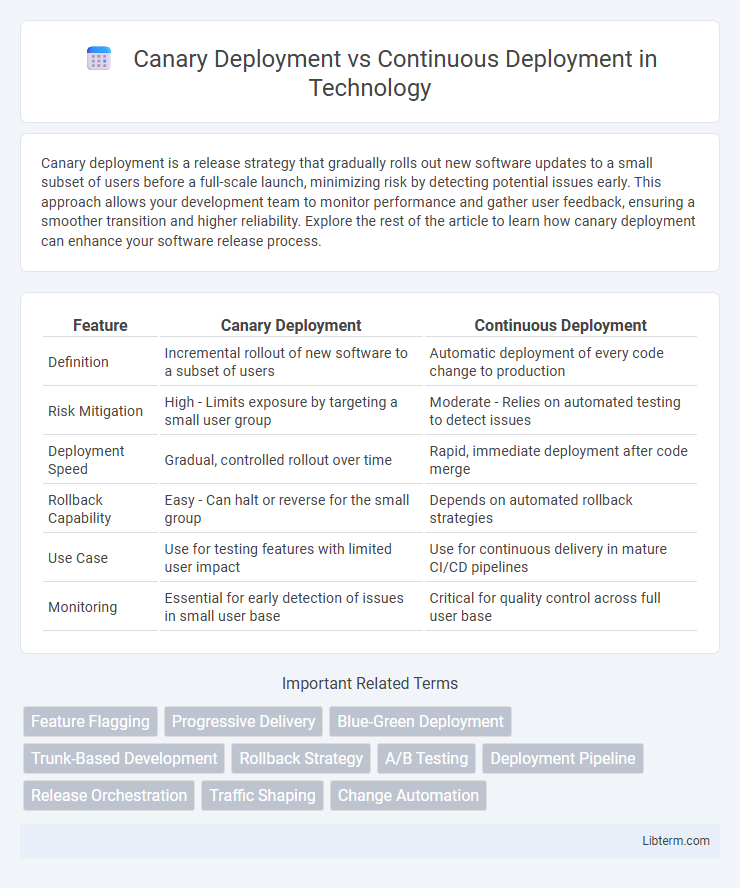Canary deployment is a release strategy that gradually rolls out new software updates to a small subset of users before a full-scale launch, minimizing risk by detecting potential issues early. This approach allows your development team to monitor performance and gather user feedback, ensuring a smoother transition and higher reliability. Explore the rest of the article to learn how canary deployment can enhance your software release process.
Table of Comparison
| Feature | Canary Deployment | Continuous Deployment |
|---|---|---|
| Definition | Incremental rollout of new software to a subset of users | Automatic deployment of every code change to production |
| Risk Mitigation | High - Limits exposure by targeting a small user group | Moderate - Relies on automated testing to detect issues |
| Deployment Speed | Gradual, controlled rollout over time | Rapid, immediate deployment after code merge |
| Rollback Capability | Easy - Can halt or reverse for the small group | Depends on automated rollback strategies |
| Use Case | Use for testing features with limited user impact | Use for continuous delivery in mature CI/CD pipelines |
| Monitoring | Essential for early detection of issues in small user base | Critical for quality control across full user base |
Introduction to Deployment Strategies
Canary deployment involves releasing new software versions to a small subset of users to monitor performance and detect issues before a full rollout. Continuous deployment automates the release of every code change that passes automated tests directly to production, enabling rapid delivery. Both strategies enhance release management but differ in risk mitigation and deployment speed.
What is Canary Deployment?
Canary Deployment is a software release strategy where new features are gradually rolled out to a small, controlled subset of users before reaching the entire user base. This method allows teams to monitor system performance and user feedback in real-time, minimizing risks and quickly identifying potential issues. Unlike Continuous Deployment, which automates the release of every validated change, Canary Deployment emphasizes cautious, phased exposure to new code changes.
What is Continuous Deployment?
Continuous Deployment automates the release process by deploying every code change that passes automated tests directly into production, ensuring rapid delivery and reduced manual intervention. This method relies on robust CI/CD pipelines and extensive testing frameworks to maintain stable software while speeding up feature delivery. It contrasts with Canary Deployment, which gradually introduces changes to subsets of users for risk mitigation before full rollout.
Key Differences Between Canary and Continuous Deployment
Canary deployment involves gradually releasing a new software version to a small subset of users before a full rollout, enabling controlled testing and quick rollback if issues arise. Continuous deployment automates the release process, pushing every code change that passes automated tests directly into production without manual intervention. The key differences lie in risk management and release strategy: canary deployment emphasizes incremental exposure and user feedback, while continuous deployment prioritizes rapid, seamless delivery with minimal manual oversight.
Advantages of Canary Deployment
Canary deployment allows incremental release of new software versions to a subset of users, minimizing risk by detecting issues early without affecting the entire user base. It provides precise control over traffic routing, enabling quick rollback if performance or errors degrade, ensuring system stability. This method enhances user experience by reducing downtime and allowing real-time monitoring of software behavior in production environments.
Advantages of Continuous Deployment
Continuous Deployment accelerates software delivery by automatically releasing every code change that passes automated tests, reducing manual intervention and minimizing time to market. This approach enhances feedback loops by enabling rapid detection and resolution of issues in production, improving product quality and user satisfaction. Continuous Deployment also fosters a culture of collaboration and innovation by allowing developers to focus on coding rather than release management, increasing overall productivity.
Use Cases for Canary Deployment
Canary deployment is ideal for minimizing risk during software releases by gradually exposing new features to a subset of users, making it suitable for critical applications requiring controlled rollouts. It enables real-time monitoring and quick rollback if issues arise, beneficial for systems with high uptime requirements such as financial services and e-commerce platforms. Continuous deployment suits environments with automated testing pipelines and frequent updates, but canary deployment is preferred when cautious release strategies are essential to maintain stability.
Use Cases for Continuous Deployment
Continuous Deployment excels in environments requiring rapid, automated delivery of features and bug fixes directly to production, such as SaaS platforms and e-commerce websites. This approach enables teams to maintain high deployment frequency with minimal manual intervention, supporting continuous improvement and quick user feedback integration. It is particularly beneficial for applications with robust automated testing pipelines and monitoring tools to ensure stability despite frequent updates.
Choosing the Right Deployment Strategy
Canary deployment minimizes risk by releasing new features to a small subset of users before full rollout, enabling real-time monitoring and quick rollback if issues arise. Continuous deployment emphasizes rapid, automated releases to production, ensuring constant delivery of updates but requiring robust testing and monitoring to prevent widespread disruptions. Selecting the right deployment strategy depends on factors such as application criticality, team capacity for monitoring, and tolerance for potential end-user impact during updates.
Conclusion: Which Deployment Approach Fits Your Needs?
Canary deployment is ideal for organizations prioritizing risk mitigation and gradual feature rollouts, enabling real-time monitoring and user feedback before full release. Continuous deployment suits teams with mature CI/CD pipelines aiming for rapid, automated delivery of small, incremental updates to production. Selecting the right approach depends on your risk tolerance, release frequency, and infrastructure maturity to balance innovation speed with system stability.
Canary Deployment Infographic

 libterm.com
libterm.com